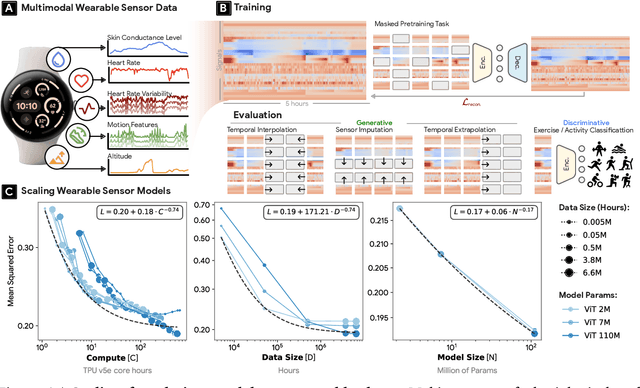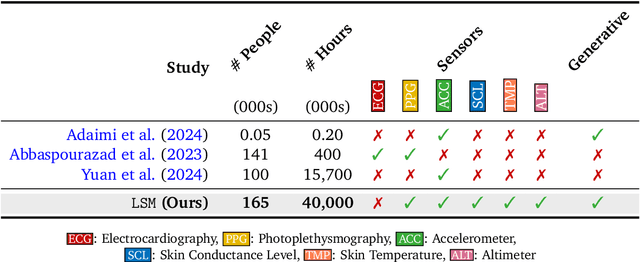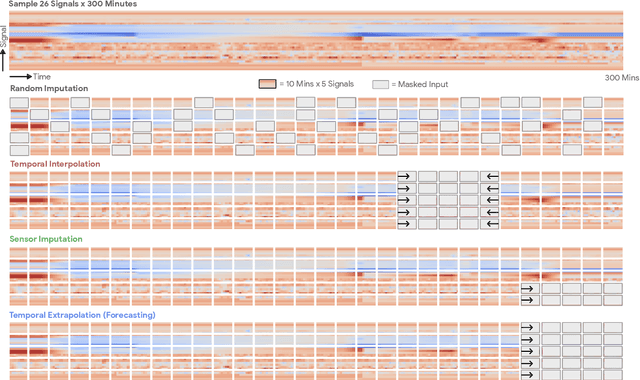Daniel McDuff
Oggi
A Scalable Framework for Evaluating Health Language Models
Apr 01, 2025Abstract:Large language models (LLMs) have emerged as powerful tools for analyzing complex datasets. Recent studies demonstrate their potential to generate useful, personalized responses when provided with patient-specific health information that encompasses lifestyle, biomarkers, and context. As LLM-driven health applications are increasingly adopted, rigorous and efficient one-sided evaluation methodologies are crucial to ensure response quality across multiple dimensions, including accuracy, personalization and safety. Current evaluation practices for open-ended text responses heavily rely on human experts. This approach introduces human factors and is often cost-prohibitive, labor-intensive, and hinders scalability, especially in complex domains like healthcare where response assessment necessitates domain expertise and considers multifaceted patient data. In this work, we introduce Adaptive Precise Boolean rubrics: an evaluation framework that streamlines human and automated evaluation of open-ended questions by identifying gaps in model responses using a minimal set of targeted rubrics questions. Our approach is based on recent work in more general evaluation settings that contrasts a smaller set of complex evaluation targets with a larger set of more precise, granular targets answerable with simple boolean responses. We validate this approach in metabolic health, a domain encompassing diabetes, cardiovascular disease, and obesity. Our results demonstrate that Adaptive Precise Boolean rubrics yield higher inter-rater agreement among expert and non-expert human evaluators, and in automated assessments, compared to traditional Likert scales, while requiring approximately half the evaluation time of Likert-based methods. This enhanced efficiency, particularly in automated evaluation and non-expert contributions, paves the way for more extensive and cost-effective evaluation of LLMs in health.
Substance over Style: Evaluating Proactive Conversational Coaching Agents
Mar 25, 2025Abstract:While NLP research has made strides in conversational tasks, many approaches focus on single-turn responses with well-defined objectives or evaluation criteria. In contrast, coaching presents unique challenges with initially undefined goals that evolve through multi-turn interactions, subjective evaluation criteria, mixed-initiative dialogue. In this work, we describe and implement five multi-turn coaching agents that exhibit distinct conversational styles, and evaluate them through a user study, collecting first-person feedback on 155 conversations. We find that users highly value core functionality, and that stylistic components in absence of core components are viewed negatively. By comparing user feedback with third-person evaluations from health experts and an LM, we reveal significant misalignment across evaluation approaches. Our findings provide insights into design and evaluation of conversational coaching agents and contribute toward improving human-centered NLP applications.
Passive Heart Rate Monitoring During Smartphone Use in Everyday Life
Mar 04, 2025Abstract:Resting heart rate (RHR) is an important biomarker of cardiovascular health and mortality, but tracking it longitudinally generally requires a wearable device, limiting its availability. We present PHRM, a deep learning system for passive heart rate (HR) and RHR measurements during everyday smartphone use, using facial video-based photoplethysmography. Our system was developed using 225,773 videos from 495 participants and validated on 185,970 videos from 205 participants in laboratory and free-living conditions, representing the largest validation study of its kind. Compared to reference electrocardiogram, PHRM achieved a mean absolute percentage error (MAPE) < 10% for HR measurements across three skin tone groups of light, medium and dark pigmentation; MAPE for each skin tone group was non-inferior versus the others. Daily RHR measured by PHRM had a mean absolute error < 5 bpm compared to a wearable HR tracker, and was associated with known risk factors. These results highlight the potential of smartphones to enable passive and equitable heart health monitoring.
A Demonstration of Adaptive Collaboration of Large Language Models for Medical Decision-Making
Oct 31, 2024



Abstract:Medical Decision-Making (MDM) is a multi-faceted process that requires clinicians to assess complex multi-modal patient data patient, often collaboratively. Large Language Models (LLMs) promise to streamline this process by synthesizing vast medical knowledge and multi-modal health data. However, single-agent are often ill-suited for nuanced medical contexts requiring adaptable, collaborative problem-solving. Our MDAgents addresses this need by dynamically assigning collaboration structures to LLMs based on task complexity, mimicking real-world clinical collaboration and decision-making. This framework improves diagnostic accuracy and supports adaptive responses in complex, real-world medical scenarios, making it a valuable tool for clinicians in various healthcare settings, and at the same time, being more efficient in terms of computing cost than static multi-agent decision making methods.
SympCam: Remote Optical Measurement of Sympathetic Arousal
Oct 27, 2024



Abstract:Recent work has shown that a person's sympathetic arousal can be estimated from facial videos alone using basic signal processing. This opens up new possibilities in the field of telehealth and stress management, providing a non-invasive method to measure stress only using a regular RGB camera. In this paper, we present SympCam, a new 3D convolutional architecture tailored to the task of remote sympathetic arousal prediction. Our model incorporates a temporal attention module (TAM) to enhance the temporal coherence of our sequential data processing capabilities. The predictions from our method improve accuracy metrics of sympathetic arousal in prior work by 48% to a mean correlation of 0.77. We additionally compare our method with common remote photoplethysmography (rPPG) networks and show that they alone cannot accurately predict sympathetic arousal "out-of-the-box". Furthermore, we show that the sympathetic arousal predicted by our method allows detecting physical stress with a balanced accuracy of 90% - an improvement of 61% compared to the rPPG method commonly used in related work, demonstrating the limitations of using rPPG alone. Finally, we contribute a dataset designed explicitly for the task of remote sympathetic arousal prediction. Our dataset contains synchronized face and hand videos of 20 participants from two cameras synchronized with electrodermal activity (EDA) and photoplethysmography (PPG) measurements. We will make this dataset available to the community and use it to evaluate the methods in this paper. To the best of our knowledge, this is the first dataset available to other researchers designed for remote sympathetic arousal prediction.
Scaling Wearable Foundation Models
Oct 17, 2024



Abstract:Wearable sensors have become ubiquitous thanks to a variety of health tracking features. The resulting continuous and longitudinal measurements from everyday life generate large volumes of data; however, making sense of these observations for scientific and actionable insights is non-trivial. Inspired by the empirical success of generative modeling, where large neural networks learn powerful representations from vast amounts of text, image, video, or audio data, we investigate the scaling properties of sensor foundation models across compute, data, and model size. Using a dataset of up to 40 million hours of in-situ heart rate, heart rate variability, electrodermal activity, accelerometer, skin temperature, and altimeter per-minute data from over 165,000 people, we create LSM, a multimodal foundation model built on the largest wearable-signals dataset with the most extensive range of sensor modalities to date. Our results establish the scaling laws of LSM for tasks such as imputation, interpolation and extrapolation, both across time and sensor modalities. Moreover, we highlight how LSM enables sample-efficient downstream learning for tasks like exercise and activity recognition.
Evidence of Cognitive Deficits andDevelopmental Advances in Generative AI: A Clock Drawing Test Analysis
Oct 15, 2024

Abstract:Generative AI's rapid advancement sparks interest in its cognitive abilities, especially given its capacity for tasks like language understanding and code generation. This study explores how several recent GenAI models perform on the Clock Drawing Test (CDT), a neuropsychological assessment of visuospatial planning and organization. While models create clock-like drawings, they struggle with accurate time representation, showing deficits similar to mild-severe cognitive impairment (Wechsler, 2009). Errors include numerical sequencing issues, incorrect clock times, and irrelevant additions, despite accurate rendering of clock features. Only GPT 4 Turbo and Gemini Pro 1.5 produced the correct time, scoring like healthy individuals (4/4). A follow-up clock-reading test revealed only Sonnet 3.5 succeeded, suggesting drawing deficits stem from difficulty with numerical concepts. These findings may reflect weaknesses in visual-spatial understanding, working memory, or calculation, highlighting strengths in learned knowledge but weaknesses in reasoning. Comparing human and machine performance is crucial for understanding AI's cognitive capabilities and guiding development toward human-like cognitive functions.
The Cognitive Capabilities of Generative AI: A Comparative Analysis with Human Benchmarks
Oct 09, 2024



Abstract:There is increasing interest in tracking the capabilities of general intelligence foundation models. This study benchmarks leading large language models and vision language models against human performance on the Wechsler Adult Intelligence Scale (WAIS-IV), a comprehensive, population-normed assessment of underlying human cognition and intellectual abilities, with a focus on the domains of VerbalComprehension (VCI), Working Memory (WMI), and Perceptual Reasoning (PRI). Most models demonstrated exceptional capabilities in the storage, retrieval, and manipulation of tokens such as arbitrary sequences of letters and numbers, with performance on the Working Memory Index (WMI) greater or equal to the 99.5th percentile when compared to human population normative ability. Performance on the Verbal Comprehension Index (VCI) which measures retrieval of acquired information, and linguistic understanding about the meaning of words and their relationships to each other, also demonstrated consistent performance at or above the 98th percentile. Despite these broad strengths, we observed consistently poor performance on the Perceptual Reasoning Index (PRI; range 0.1-10th percentile) from multimodal models indicating profound inability to interpret and reason on visual information. Smaller and older model versions consistently performed worse, indicating that training data, parameter count and advances in tuning are resulting in significant advances in cognitive ability.
Global atmospheric data assimilation with multi-modal masked autoencoders
Jul 16, 2024Abstract:Global data assimilation enables weather forecasting at all scales and provides valuable data for studying the Earth system. However, the computational demands of physics-based algorithms used in operational systems limits the volume and diversity of observations that are assimilated. Here, we present "EarthNet", a multi-modal foundation model for data assimilation that learns to predict a global gap-filled atmospheric state solely from satellite observations. EarthNet is trained as a masked autoencoder that ingests a 12 hour sequence of observations and learns to fill missing data from other sensors. We show that EarthNet performs a form of data assimilation producing a global 0.16 degree reanalysis dataset of 3D atmospheric temperature and humidity at a fraction of the time compared to operational systems. It is shown that the resulting reanalysis dataset reproduces climatology by evaluating a 1 hour forecast background state against observations. We also show that our 3D humidity predictions outperform MERRA-2 and ERA5 reanalyses by 10% to 60% between the middle troposphere and lower stratosphere (5 to 20 km altitude) and our 3D temperature and humidity are statistically equivalent to the Microwave integrated Retrieval System (MiRS) observations at nearly every level of the atmosphere. Our results indicate significant promise in using EarthNet for high-frequency data assimilation and global weather forecasting.
The Responsible Foundation Model Development Cheatsheet: A Review of Tools & Resources
Jun 26, 2024


Abstract:Foundation model development attracts a rapidly expanding body of contributors, scientists, and applications. To help shape responsible development practices, we introduce the Foundation Model Development Cheatsheet: a growing collection of 250+ tools and resources spanning text, vision, and speech modalities. We draw on a large body of prior work to survey resources (e.g. software, documentation, frameworks, guides, and practical tools) that support informed data selection, processing, and understanding, precise and limitation-aware artifact documentation, efficient model training, advance awareness of the environmental impact from training, careful model evaluation of capabilities, risks, and claims, as well as responsible model release, licensing and deployment practices. We hope this curated collection of resources helps guide more responsible development. The process of curating this list, enabled us to review the AI development ecosystem, revealing what tools are critically missing, misused, or over-used in existing practices. We find that (i) tools for data sourcing, model evaluation, and monitoring are critically under-serving ethical and real-world needs, (ii) evaluations for model safety, capabilities, and environmental impact all lack reproducibility and transparency, (iii) text and particularly English-centric analyses continue to dominate over multilingual and multi-modal analyses, and (iv) evaluation of systems, rather than just models, is needed so that capabilities and impact are assessed in context.
 Add to Chrome
Add to Chrome Add to Firefox
Add to Firefox Add to Edge
Add to Edge